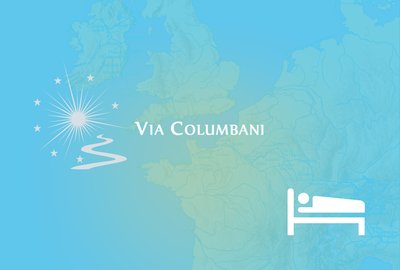Pont-Audemer to Notre-Dame de Gravenchon

Normandie
15. Pont-Audemer to Notre-Dame de Gravenchon
Medium
5h30
20,8km
+235m
-226m
Step
Embed this item to access it offline
After crossing the river "La Risle", we arrive on the plateau on the banks of the Seine, to take the Aquarius Ravine and find the Nature Reserve of the Marais Vernier with the Grand'Mare Game Reserve. The path continues with cereal fields and pastures until the arrival.
7 points of interest
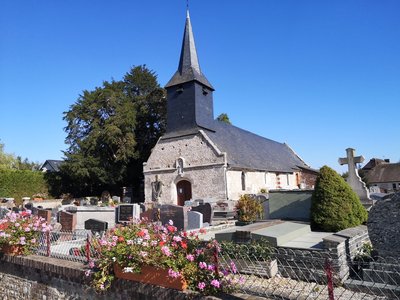
Église Saint-Thibaut à Saint-Mards-de-Blacarville - Amis saint Colomban TouristSaint-Thibaut Church in St-Mards-de-Blacarville
The church is of Romanesque origin. Its choir dates from the 13th century, and its nave was rebuilt in the 15th century. It is the church of Blacarville. That of Saint-Mards (late 12th century) was demolished in 1892. The choir and the tower were transformed into an English cottage.
The building is oriented and follows an elongated plan ending with a flat chevet.
The gable wall features a basket-handle portal surmounted by a statue in an arched niche with a decoration of three-lobed lancets. The chevet is pierced by two arched openings surmounted by a lobe in a pointed arch bay. It is flanked on its south side by a sacristy. The gable wall is surmounted by a bell tower with a square base topped by an octagonal corneville-type spire.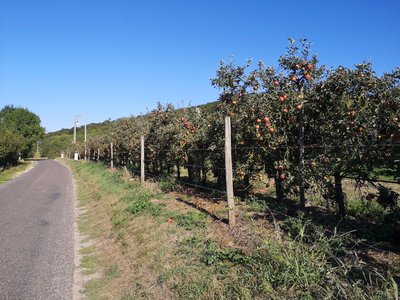
Les Pommiers sur la Via Columbani - Amis saint Colomban CulturalThe apple in Sainte-Opportune-la-Mare
The history of the apple begins in prehistoric times in the Central Asian plateaus to arrive at the domestic apple (Malus pumila) consumed today.
After the decline due to barbarian invasions, such as the Huns, paradoxically originating from the same regions as the apple, 32 varieties were created between the 8th and 15th centuries. This revival took place mainly in Normandy. Indeed, as soon as the "Viking" invasions were over, the clergy and the nobility encouraged the planting of apple trees. Thus, before its annexation by France in 1204, this country was a real apple tree nursery. After its invasion, it became the orchard of France.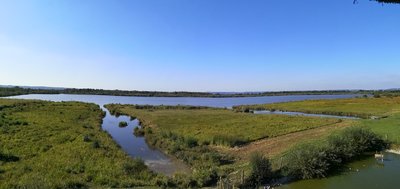
Réserve naturelle d'oiseaux de la Grand’Mare - Amis saint Colomban PanoramicThe Marais-Vernier National Nature Reserve - La Grand'Mare
The Nature Reserve is a 148-hectare natural area of great ecological interest. Located in the Marais Vernier, in an old meander of the Seine, it is composed of the former National Nature Reserve of Mannevilles, owned by the State since 1973 and the Marais de Bouquelon acquired in 2002 by the Regional Nature Park of the Loops of the Norman Seine. The Park is responsible for its management. It is characterized by wet meadows that have developed on peaty environments, characterized by a very specific flora: loose-flowered orchids, drosera, marsh troscart, cirse des anglais...
The site of the Reserve is conducive to nesting and hosts many migratory birds: snipe, curlew, corncrake ... The white stork present since 1993, can be observed in flight or on one of the many nests built in the marsh.
It is in these places that the experience of extensive grazing by Highland cattle and then Camargue horses was born at the end of the 1970s. Chosen for their rusticity, and their lighter weight adapted to the peaty and humid soil, these hardy "brushcutters" rebalance the natural environment.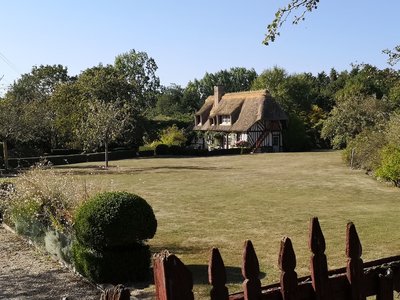
Maison Normande sur la Via Columbani - Amis saint Colomban CulturalMaison normande à-Sainte-Opportune-la-Mare
The real Norman house is not just any house. It's a house made of mud, from the land of his country. A house that blends perfectly into its environment, in a harmonious plant-mineral balance, modulated over the years. It is a house of tradition that must be preserved, in its foundations and also in its spirit. For the architectural heritage is not only the illustrious castle or the listed manor house of the canton, it is also the modest house of the village, the ancestors' farm and its annex buildings... It is these peasant constructions, often of great quality, moving in their simplicity and great diversity, witnesses of rural civilisations from which we all, so to speak, come.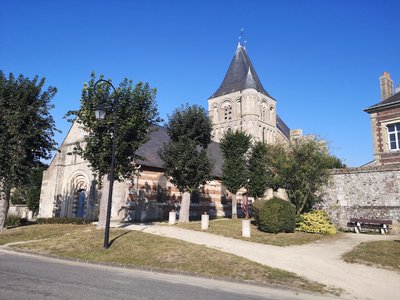
Église Notre-Dame de Bonport à Quillebeuf-sur-Seine - Amis saint Colomban TouristNotre-Dame Church de Bonport à Quillebeuf
In the Seine estuary, discover a church of Romanesque origin with its 12th century portal and porch, which was remodelled in the 16th century with a Gothic-style choir and an exceptional lantern tower. The name Notre-Dame de Bon Port evokes the maritime character of the city. It is therefore not surprising to find ex-voto and marine graffiti, as well as an admirable collection of model ships. Also worth seeing are the 15th century polychrome stained-glass windows that evoke the history of navigation on the Seine in the 18th and 19th centuries.
The legend of the Telemachus: by far the most famous of the ships displayed in the church. The Télémaque sank in Quillebeuf on 3 January 1790 with, it is said, the fortune of King Louis XVI and the treasures of the abbeys of the Seine.
La Via Columbani emprunte le Bac de Quilleboeuf-sur-Seine. - Amis saint Colomban PanoramicThe Bac de Quillebeuf-sur-Seine
The Bac de Quillebeuf-sur-Seine was maintained following the construction of the Tancarville and Brotonne Bridges, thanks to the determination of the inhabitants of all the surrounding villages, who did not want to see this means of direct connection disappear.
In 1873, the steam ferry replaced the old sailing ferry, thus limiting the risks of drifting due to strong currents. It is because of these drifts that we can still see today disused holds several hundred meters from the usual slipway, on each of the two shores.
The Bac de Quillebeuf-sur-Seine is also accessible to pedestrians, allowing you to discover Quillebeuf-sur-Seine from a new point of view as the currents change!
Église Saint-Georges à Notre-Dame de Gravenchon - Amis saint Colomban TouristSaint-Georges Church in Notre-Dame de Gravenchon
The development of the Port-Jérôme-Gravenchon refinery, located in Port-Jérôme-sur-Seine, has generated tremendous demographic and economic development on the banks of the Seine.
The port was created in 1860. Its name is a tribute to King Jérôme Bonaparte, Napoleon I's younger brother. Oil storage began in 1933 to supply a refinery. The whole complex was set on fire in 1940 to prevent the enemy from taking it over. When the refinery was liberated and rebuilt, today it can process up to 12 million tons of crude oil.
A symbol of economic growth, the Church of St. George was built in 1958 on the site of the first church destroyed in the 19th century. To underline the sobriety of the architectural lines, Max Ingrand created the beautiful modern stained glass windows that illuminate the church. Inside (but the church is not always open) you can admire a 15th century Virgin and Child and a statue of St George slaying the dragon that adorns the east façade.
Description
On the square in front of the Saint-Ouen church, turn right into the Rue de la République, cross the Risle, place de Verdun, turn left on the Route de Quillebeuf.
- Second street on the left, rue Louis Leble, left on route de Quillebeuf, first street on the left on Côte de la Lorie, in La Lorie second street on the right on the plateau
- Turn right on rue de Germare, left in front of the calvary, rue du Calvaire, cross rue Bois Colin, in Saint-Mards-de-Blacarville, turn left in front of the church, stay on the main road, left on the highway, right after the bridge
- Turn right at the crossroads with D90 route du Bouquelon, grassy road between two houses, left at the junction with route de la Grande Mare, at the quai de la Forge continue on the main road, route de la Grande Mare, la Forestière, cité le Bout des Rue, take the bridge to cross the highway.
- First road on the right, Les Canons, stay on Cité des Canons, turning right then left, second road on the left, left on rue du Cimetière
- In Quillebeuf-sur-Seine straight on rue Saint-Seurin, in front of the church turn right at Place du Phare, fourth street on the right Grande Rue, take the ferry to cross the Seine.
- Exit the ferry straight ahead, avenue du Président Kennedy in the industrial zone, cross the D81 straight ahead, continue at the big roundabout on avenue du Président Kennedy, at the roundabout go straight ahead on avenue Anatole France, you arrive at the Saint-Georges de Notre-Dame de Gravenchon church.
- Departure : Saint-Ouen Church, rue de la République 27 500 Pont-Audemer.
- Arrival : Saint-Georges Church, avenue Anatole France, 76330 Notre-Dame de Gravenchon
- Towns crossed : Normandie
Altimetric profile
Report a problem or an error
If you have found an error on this page or if you have noticed any problems during your hike, please report them to us here:







